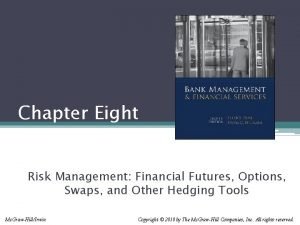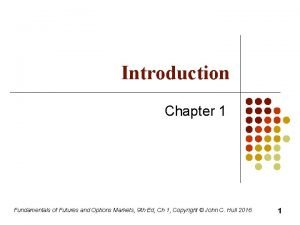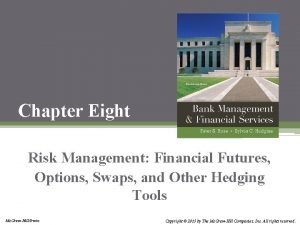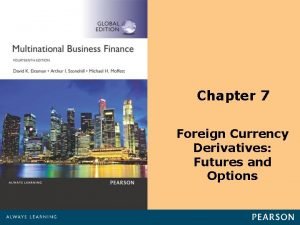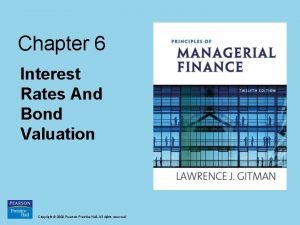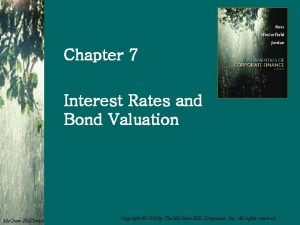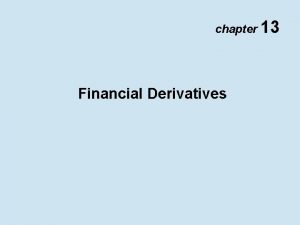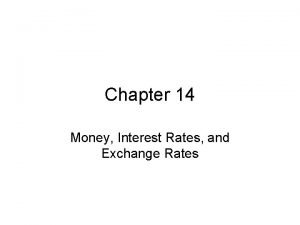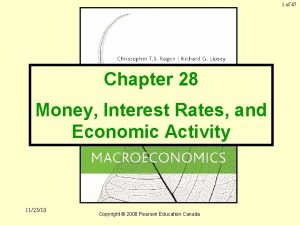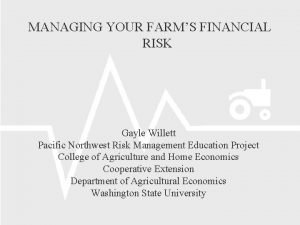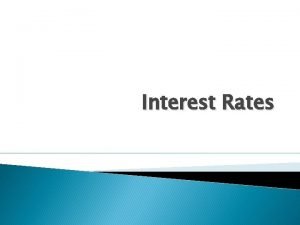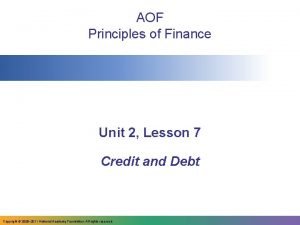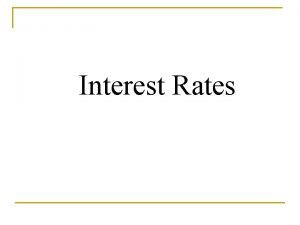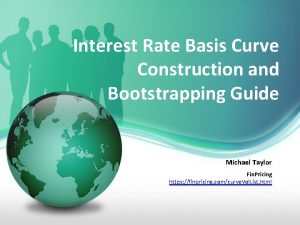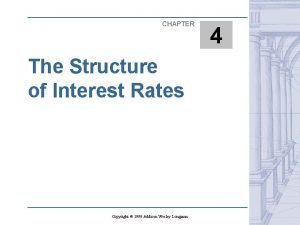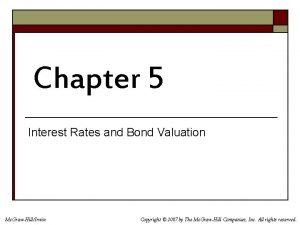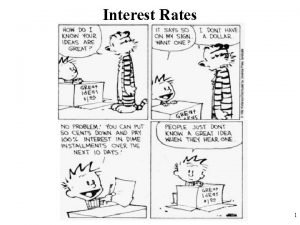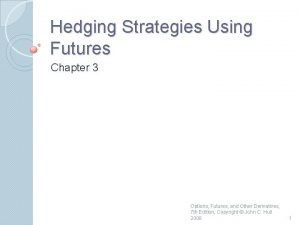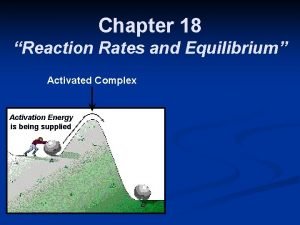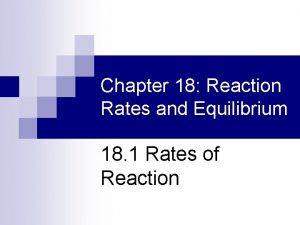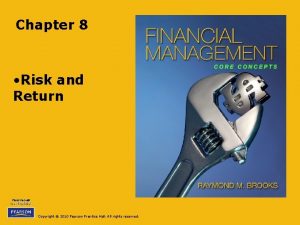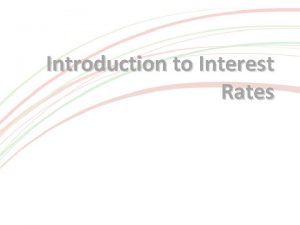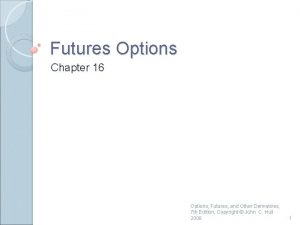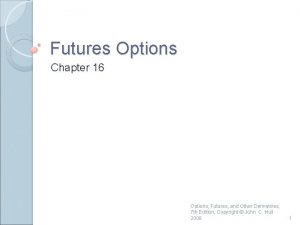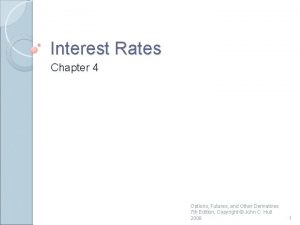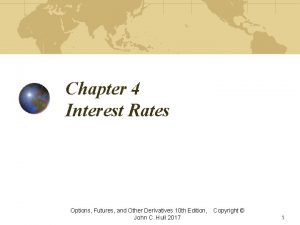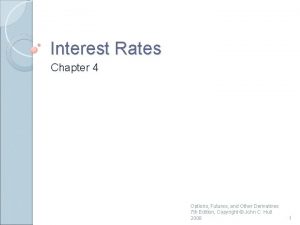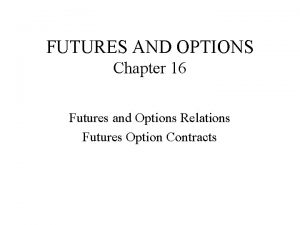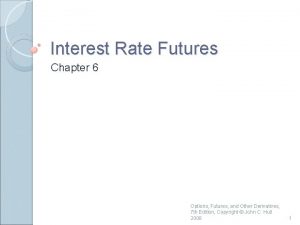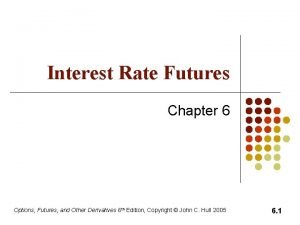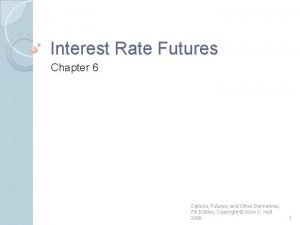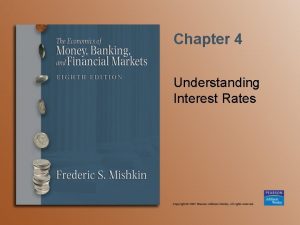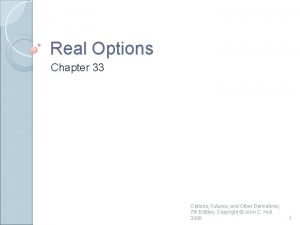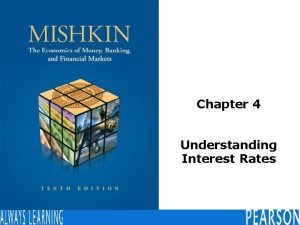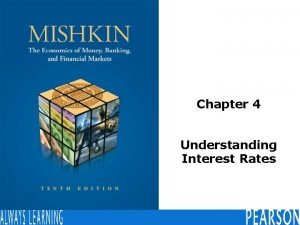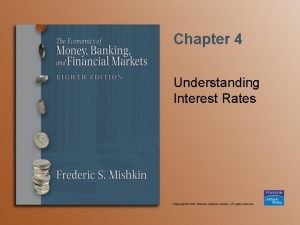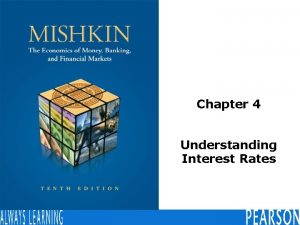Chapter 4 Interest Rates Options Futures and Other








































- Slides: 40

Chapter 4 Interest Rates Options, Futures, and Other Derivatives 8 th Edition, Copyright © John C. Hull 2012 1

Types of Rates Treasury rates LIBOR rates Repo rates Options, Futures, and Other Derivatives 8 th Edition, Copyright © John C. Hull 2012 2

Treasury Rates on instruments issued by a government in its own currency Options, Futures, and Other Derivatives 8 th Edition, Copyright © John C. Hull 2012 3

LIBOR and LIBID LIBOR is the rate of interest at which a bank is prepared to deposit money with another bank. (The second bank must typically have a AA rating) LIBOR is compiled once a day by the British Bankers Association on all major currencies for maturities up to 12 months LIBID is the rate which a AA bank is prepared to pay on deposits from anther bank Options, Futures, and Other Derivatives 8 th Edition, Copyright © John C. Hull 2012 4

Repo Rates Repurchase agreement is an agreement where a financial institution that owns securities agrees to sell them today for X and buy them bank in the future for a slightly higher price, Y The financial institution obtains a loan. The rate of interest is calculated from the difference between X and Y and is known as the repo rate Options, Futures, and Other Derivatives 8 th Edition, Copyright © John C. Hull 2012 5

The Risk-Free Rate The short-term risk-free rate traditionally used by derivatives practitioners is LIBOR The Treasury rate is considered to be artificially low for a number of reasons (See Business Snapshot 4. 1) As will be explained in later chapters: Eurodollar futures and swaps are used to extend the LIBOR yield curve beyond one year The overnight indexed swap rate is increasingly being used instead of LIBOR as the risk-free rate Options, Futures, and Other Derivatives 8 th Edition, Copyright © John C. Hull 2012 6

Measuring Interest Rates The compounding frequency used for an interest rate is the unit of measurement The difference between quarterly and annual compounding is analogous to the difference between miles and kilometers Options, Futures, and Other Derivatives 8 th Edition, Copyright © John C. Hull 2012 7

Impact of Compounding When we compound m times per year at rate R an amount A grows to A(1+R/m)m in one year Compounding frequency Value of $100 in one year at 10% Annual (m=1) 110. 00 Semiannual (m=2) 110. 25 Quarterly (m=4) 110. 38 Monthly (m=12) 110. 47 Weekly (m=52) 110. 51 Daily (m=365) 110. 52 Options, Futures, and Other Derivatives 8 th Edition, Copyright © John C. Hull 2012 8

Continuous Compounding (Page 79) In the limit as we compound more and more frequently we obtain continuously compounded interest rates $100 grows to $100 e. RT when invested at a continuously compounded rate R for time T $100 received at time T discounts to $100 e-RT at time zero when the continuously compounded discount rate is R Options, Futures, and Other Derivatives 8 th Edition, Copyright © John C. Hull 2012 9

Conversion Formulas (Page 79) Define Rc : continuously compounded rate Rm: same rate with compounding m times per year Options, Futures, and Other Derivatives 8 th Edition, Copyright © John C. Hull 2012 10

Examples 10% with semiannual compounding is equivalent to 2 ln(1. 05)=9. 758% with continuous compounding is equivalent to 4(e 0. 08/4 -1)=8. 08% with quarterly compounding Rates used in option pricing are nearly always expressed with continuous compounding Options, Futures, and Other Derivatives 8 th Edition, Copyright © John C. Hull 2012 11

Zero Rates A zero rate (or spot rate), for maturity T is the rate of interest earned on an investment that provides a payoff only at time T Options, Futures, and Other Derivatives 8 th Edition, Copyright © John C. Hull 2012 12

Example (Table 4. 2, page 81) Maturity (years) Zero rate (cont. comp. 0. 5 5. 0 1. 0 5. 8 1. 5 6. 4 2. 0 6. 8 Options, Futures, and Other Derivatives 8 th Edition, Copyright © John C. Hull 2012 13

Bond Pricing To calculate the cash price of a bond we discount each cash flow at the appropriate zero rate In our example, theoretical price of a twoyear bond providing a 6% coupon semiannually is Options, Futures, and Other Derivatives 8 th Edition, Copyright © John C. Hull 2012 14

Bond Yield The bond yield is the discount rate that makes the present value of the cash flows on the bond equal to the market price of the bond Suppose that the market price of the bond in our example equals its theoretical price of 98. 39 The bond yield (continuously compounded) is given by solving to get y=0. 0676 or 6. 76%. Options, Futures, and Other Derivatives 8 th Edition, Copyright © John C. Hull 2012 15

Par Yield The par yield for a certain maturity is the coupon rate that causes the bond price to equal its face value. In our example we solve Options, Futures, and Other Derivatives 8 th Edition, Copyright © John C. Hull 2012 16

Par Yield continued In general if m is the number of coupon payments per year, d is the present value of $1 received at maturity and A is the present value of an annuity of $1 on each coupon date (in our example, m = 2, d = 0. 87284, and A = 3. 70027) Options, Futures, and Other Derivatives 8 th Edition, Copyright © John C. Hull 2012 17

Data to Determine Zero Curve (Table 4. 3, page 82) Bond Principal Time to Maturity (yrs) 100 0. 25 0 97. 5 100 0. 50 0 94. 9 100 1. 00 0 90. 0 100 1. 50 8 96. 0 100 2. 00 12 101. 6 * Half Coupon per year ($)* Bond price ($) the stated coupon is paid each year Options, Futures, and Other Derivatives 8 th Edition, Copyright © John C. Hull 2012 18

The Bootstrap Method An amount 2. 5 can be earned on 97. 5 during 3 months. Because 100=97. 5 e 0. 10127× 0. 25 the 3 -month rate is 10. 127% with continuous compounding Similarly the 6 month and 1 year rates are 10. 469% and 10. 536% with continuous compounding Options, Futures, and Other Derivatives 8 th Edition, Copyright © John C. Hull 2012 19

The Bootstrap Method continued To calculate the 1. 5 year rate we solve to get R = 0. 10681 or 10. 681% Similarly the two-year rate is 10. 808% Options, Futures, and Other Derivatives 8 th Edition, Copyright © John C. Hull 2012 20

Zero Curve Calculated from the Data (Figure 4. 1, page 84) Zero Rate (%) 10. 681 10. 469 10. 808 10. 536 10. 127 Maturity (yrs) Options, Futures, and Other Derivatives 8 th Edition, Copyright © John C. Hull 2012 21

Forward Rates The forward rate is the future zero rate implied by today’s term structure of interest rates Options, Futures, and Other Derivatives 8 th Edition, Copyright © John C. Hull 2012 22

Formula for Forward Rates Suppose that the zero rates for time periods T 1 and T 2 are R 1 and R 2 with both rates continuously compounded. The forward rate for the period between times T 1 and T 2 is This formula is only approximately true when rates are not expressed with continuous compounding Options, Futures, and Other Derivatives 8 th Edition, Copyright © John C. Hull 2012 23

Application of the Formula Year (n) Zero rate for n-year investment (% per annum) Forward rate for nth year (% per annum) 1 3. 0 2 4. 0 5. 0 3 4. 6 5. 8 4 5. 0 6. 2 5 5. 5 6. 5 Options, Futures, and Other Derivatives 8 th Edition, Copyright © John C. Hull 2012 24

Instantaneous Forward Rate The instantaneous forward rate for a maturity T is the forward rate that applies for a very short time period starting at T. It is where R is the T-year rate Options, Futures, and Other Derivatives 8 th Edition, Copyright © John C. Hull 2012 25

Upward vs Downward Sloping Yield Curve For an upward sloping yield curve: Fwd Rate > Zero Rate > Par Yield For a downward sloping yield curve Par Yield > Zero Rate > Fwd Rate Options, Futures, and Other Derivatives 8 th Edition, Copyright © John C. Hull 2012 26

Forward Rate Agreement A forward rate agreement (FRA) is an OTC agreement that a certain rate will apply to a certain principal during a certain future time period Options, Futures, and Other Derivatives 8 th Edition, Copyright © John C. Hull 2012 27

Forward Rate Agreement: Key Results An FRA is equivalent to an agreement where interest at a predetermined rate, RK is exchanged for interest at the market rate An FRA can be valued by assuming that the forward LIBOR interest rate, RF , is certain to be realized This means that the value of an FRA is the present value of the difference between the interest that would be paid at interest at rate RF and the interest that would be paid at rate RK Options, Futures, and Other Derivatives 8 th Edition, Copyright © John C. Hull 2012 28

Valuation Formulas If the period to which an FRA applies lasts from T 1 to T 2, we assume that RF and RK are expressed with a compounding frequency corresponding to the length of the period between T 1 and T 2 With an interest rate of RK, the interest cash flow is RK (T 2 –T 1) at time T 2 With an interest rate of RF, the interest cash flow is RF(T 2 –T 1) at time T 2 Options, Futures, and Other Derivatives 8 th Edition, Copyright © John C. Hull 2012 29

Valuation Formulas continued When the rate RK will be received on a principal of L the value of the FRA is the present value of received at time T 2 Options, Futures, and Other Derivatives 8 th Edition, Copyright © John C. Hull 2012 30

Example An FRA entered into some time ago ensures that a company will receive 4% (s. a. ) on $100 million for six months starting in 1 year Forward LIBOR for the period is 5% (s. a. ) The 1. 5 year rate is 4. 5% with continuous compounding The value of the FRA (in $ millions) is Options, Futures, and Other Derivatives 8 th Edition, Copyright © John C. Hull 2012 31

Example continued If the six-month interest rate in one year turns out to be 5. 5% (s. a. ) there will be a payoff (in $ millions) of in 1. 5 years The transaction might be settled at the oneyear point for an equivalent payoff of Options, Futures, and Other Derivatives 8 th Edition, Copyright © John C. Hull 2012 32

Duration (page 89 -90) Duration of a bond that provides cash flow ci at time ti is where B is its price and y is its yield (continuously compounded) Options, Futures, and Other Derivatives 8 th Edition, Copyright © John C. Hull 2012 33

Key Duration Relationship Duration is important because it leads to the following key relationship between the change in the yield on the bond and the change in its price Options, Futures, and Other Derivatives 8 th Edition, Copyright © John C. Hull 2012 34

Key Duration Relationship continued When the yield y is expressed with compounding m times per year The expression is referred to as the “modified duration” Options, Futures, and Other Derivatives 8 th Edition, Copyright © John C. Hull 2012 35

Bond Portfolios The duration for a bond portfolio is the weighted average duration of the bonds in the portfolio with weights proportional to prices The key duration relationship for a bond portfolio describes the effect of small parallel shifts in the yield curve What exposures remain if duration of a portfolio of assets equals the duration of a portfolio of liabilities? Options, Futures, and Other Derivatives 8 th Edition, Copyright © John C. Hull 2012 36

Convexity The convexity, C, of a bond is defined as This leads to a more accurate relationship When used for bond portfolios it allows larger shifts in the yield curve to be considered, but the shifts still have to be parallel Options, Futures, and Other Derivatives 8 th Edition, Copyright © John C. Hull 2012 37

Theories of the Term Structure Page 91 -92 Expectations Theory: forward rates equal expected future zero rates Market Segmentation: short, medium and long rates determined independently of each other Liquidity Preference Theory: forward rates higher than expected future zero rates Options, Futures, and Other Derivatives 8 th Edition, Copyright © John C. Hull 2012 38

Liquidity Preference Theory Suppose that the outlook for rates is flat and you have been offered the following choices Maturity Deposit rate Mortgage rate 1 year 3% 6% 5 year 3% 6% Which would you choose as a depositor? Which for your mortgage? Options, Futures, and Other Derivatives 8 th Edition, Copyright © John C. Hull 2012 39

Liquidity Preference Theory cont To match the maturities of borrowers and lenders a bank has to increase long rates above expected future short rates In our example the bank might offer Maturity Deposit rate Mortgage rate 1 year 3% 6% 5 year 4% 7% Options, Futures, and Other Derivatives 8 th Edition, Copyright © John C. Hull 2012 40
 Options futures and other derivatives
Options futures and other derivatives Options futures and risk management
Options futures and risk management Introduction to futures and options
Introduction to futures and options Options futures and risk management
Options futures and risk management Currency futures
Currency futures Tailing the hedge
Tailing the hedge Chapter 7 interest rates and bond valuation
Chapter 7 interest rates and bond valuation Your uncle would like to restrict his interest rate risk
Your uncle would like to restrict his interest rate risk Chapter 6 interest rates and bond valuation
Chapter 6 interest rates and bond valuation Chapter 7 interest rates and bond valuation
Chapter 7 interest rates and bond valuation Chapter 6 interest rates and bond valuation
Chapter 6 interest rates and bond valuation Futures style options
Futures style options Forwards vs futures vs options vs swaps
Forwards vs futures vs options vs swaps A rate is a ratio that compares
A rate is a ratio that compares Ratios and proportions guided notes
Ratios and proportions guided notes Ratios rates and unit rates
Ratios rates and unit rates Ratios rates and unit rates
Ratios rates and unit rates Cheapest to deliver futures
Cheapest to deliver futures Add-on yield
Add-on yield Hedging interest rate risk with futures
Hedging interest rate risk with futures Ssema
Ssema Interest rates and price level
Interest rates and price level Interest rates and price level
Interest rates and price level Graphing monetary and fiscal policy interactions
Graphing monetary and fiscal policy interactions Financial risk definition
Financial risk definition Interest rates quotes
Interest rates quotes Effective annual rate
Effective annual rate Determinants of interest rates
Determinants of interest rates Economics unit 2 lesson 7
Economics unit 2 lesson 7 Nominal v. real interest rates
Nominal v. real interest rates Interest rates
Interest rates Basis curve
Basis curve Interest rates
Interest rates Interest rates
Interest rates Shifters of demand for loanable funds
Shifters of demand for loanable funds Simple and compound interest
Simple and compound interest Futures hedging strategies
Futures hedging strategies Chapter 18 review chemical equilibrium section 3 answer key
Chapter 18 review chemical equilibrium section 3 answer key Chapter 18 reaction rates and equilibrium
Chapter 18 reaction rates and equilibrium Chapter 18 reaction rates and equilibrium
Chapter 18 reaction rates and equilibrium Chapter 8 risk and rates of return problem solutions
Chapter 8 risk and rates of return problem solutions

